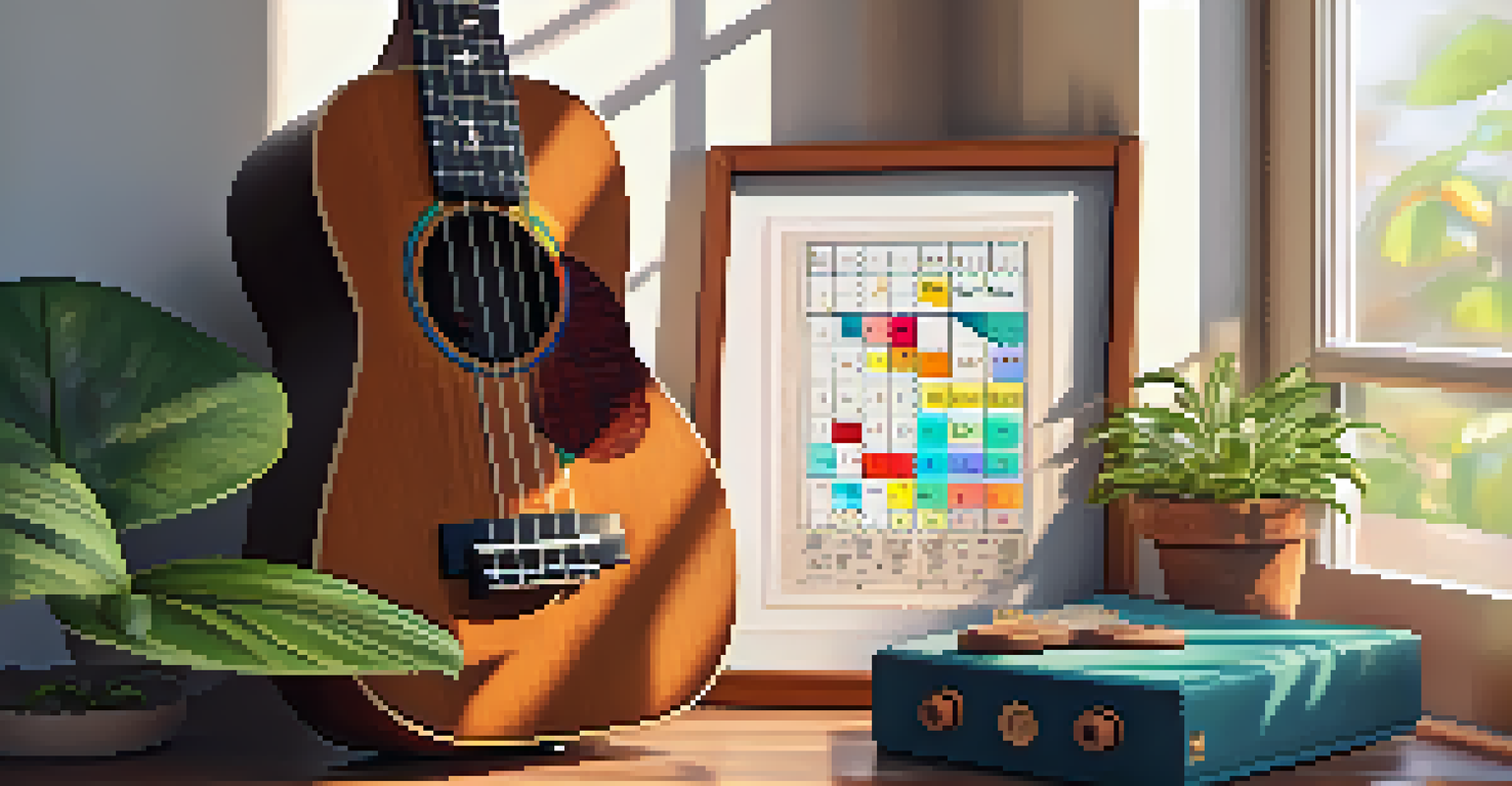Transposing Popular Songs for Ukulele: A Step-by-Step Guide

Understanding Transposition: What It Is and Why You Need It
Transposition is the process of changing the key of a song, which is essential for making a piece of music fit your vocal range or the instruments you're using. For example, if a song is too high for your voice, you might transpose it down a couple of steps to make it comfortable to sing. Similarly, transposing can help when you want to play a song with friends who are using different instruments.
Music can change the world because it can change people.
Think of transposition like adjusting the volume on your stereo—sometimes you need to turn it up or down to get the best sound. It allows you to customize the music to suit your needs, making it more enjoyable to play and sing along. The ukulele, with its cheerful sound, can be a perfect match for a variety of songs when transposed correctly.
Understanding how to transpose songs not only enhances your playing experience but also builds your music theory knowledge. You'll find that many popular songs can be easily adapted to suit your style, making you a more versatile musician. So, let’s dive into the process of transposing songs specifically for the ukulele.
Gather Your Tools: Chord Chart and Ukulele Tuner
Before you start transposing, ensure you have the right tools at your disposal. A chord chart of the song you want to transpose will be invaluable, as it shows the original chords used. Additionally, having a ukulele tuner handy ensures that your instrument is in tune, which is crucial for good sound quality.

You can find chord charts online, or you may already have a songbook at home. Websites and apps that provide ukulele chords often allow you to see the original key and the chords used, making it easier to visualize what you need to change. A well-tuned ukulele will make your transposed song sound much better, so don't skip this step!
Transposition Simplifies Music
Transposing changes the key of a song to match your vocal range or instrument, enhancing your overall playing experience.
Having these tools ready will set you up for success. With a clear chord chart and a tuned ukulele, you're equipped to explore the exciting world of transposition. Now, let’s look at how to identify the key of the song you want to transpose.
Identifying the Key of the Original Song
The first step in transposing a song is to determine its original key. The key usually dictates the chords you will play, often indicated at the beginning of the sheet music or chord chart. For instance, if you see the chords C, G, and F, the song is likely in the key of C.
Where words fail, music speaks.
You can also use a piano or a musical keyboard to help identify the key by playing the root chords. Listening to the song and finding the tonic note—the ‘home’ note that feels stable—can also guide you. Once you’ve pinpointed the key, you’re ready to move on to determining how many steps you want to transpose.
This step is crucial, as it lays the foundation for the rest of the process. Knowing the original key will help you make informed decisions about how to adjust the chords. With this knowledge in hand, let’s explore how to transpose those chords!
How to Transpose Chords Up or Down: A Simple Method
Transposing chords involves moving them up or down by a certain number of steps. For example, if you want to shift a song from the key of C to the key of D, you’d move each chord up by two steps. Chords are typically represented by letters, so C becomes D, G becomes A, and F becomes G.
A helpful tool for transposing is a chart that outlines the musical alphabet (A, B, C, D, E, F, G) and their respective steps. This way, you can easily visualize how far to move each chord. If you're moving down, simply count backward through the alphabet to find your new chords.
Use Tools for Successful Transposing
Having a chord chart and a tuner is essential for accurately transposing songs and ensuring they sound great on your ukulele.
Remember, practice makes perfect! Try transposing a simple song like 'Twinkle, Twinkle, Little Star' to get familiar with the process. Once you feel comfortable, you’ll be ready to tackle more complex songs with confidence.
Using a Capo: An Alternative to Transposing
If you find transposing a bit tricky, using a capo can be a fantastic alternative. A capo is a device that clamps onto the neck of the ukulele, allowing you to raise the pitch of all the strings. For instance, placing a capo on the second fret raises the pitch by a whole step, simplifying the process of playing in a different key.
This method is particularly useful if you want to maintain the original chord shapes while playing. You can play the song as if it’s still in its original key, but the sound will be higher. It’s like having a personal pitch adjuster right at your fingertips!
Experimenting with a capo can also inspire creativity in your playing. As you explore different positions on the fretboard, you might discover new sounds and chord voicings. Using a capo can make playing more fun, so don’t hesitate to give it a try!
Practicing Your Transposed Song on the Ukulele
Once you've transposed the song, it's time to practice! Start slowly, playing each chord in the new key until you feel comfortable with the transitions. It can be helpful to listen to the original song while you practice, as this will help you stay in tune with the rhythm and melody.
Don't be afraid to break the song down into smaller sections. Focus on mastering each part before putting it all together. This approach will prevent you from feeling overwhelmed and will help you build confidence as you progress.
Practice and Perform with Confidence
Practicing your transposed song helps you build confidence, allowing you to enjoy sharing your music with others.
As you practice, consider adding your personal touch to the song. You might experiment with strumming patterns or fingerpicking, which can make your rendition unique. Remember, the goal is to enjoy the process and make the music your own!
Performing: Sharing Your Transposed Song with Others
After you’ve practiced enough, it’s time to perform! Whether it’s for friends, family, or a larger audience, sharing your music can be incredibly rewarding. Performing a transposed song allows you to showcase your hard work and creativity, and it can be a fun way to connect with others through music.
Don’t stress about hitting every note perfectly; focus on conveying the emotion of the song. Your audience will appreciate your effort and passion more than perfection. Feel free to share the story behind the song or why you chose to transpose it, as this can create a deeper connection with your listeners.

Remember, every performance is an opportunity to learn and grow as a musician. Embrace the experience and enjoy the moment, knowing you’ve put in the work to make the song your own!